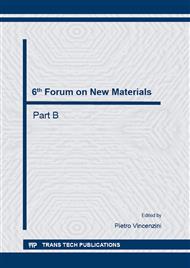p.75
p.85
p.93
p.97
p.103
p.111
p.115
p.121
p.131
Leaching Behavior of Salt Wastes Conditioned with Sodalite Blended with Two Different Glass Powders
Abstract:
Two different glass powders (a commercially available glass frit and a borosilicate glass) have been used as blending agents for sodalite, an aluminosilicate mineral able to condition chloride salt wastes from pyrometallurgical processes. The synthesis of the mineral phase has been made through a process recently proposed by Idaho National Laboratory in USA, starting from a homogeneous powder of nepheline, chloride salts and glass. The mix, put into an alumina crucible, was introduced in a furnace inside an argon-atmosphere glove-box. The furnace temperature was then raised to 925 C, where it was kept for 7 hours. Leach tests under static conditions, according to ASTM C1285-02, have then been carried out on the final waste forms at room temperature (23 C) and in an oven at 90 C. SEM investigations have also been made before and after leach tests, in order to check the status of the powders. In particular the effect of the leaching process on the surface of the sodalite grains at 90 C from 30 to 150 days has been evidenced. The results obtained in the present study have been usefully compared to those from a similar test on a sodalite added with a glass frit by Idaho National Laboratory. Financial support from the Nuclear Fission Safety Program of the European Union is gratefully acknowledged (project ACSEPT, contract FP7-CP-2007-211 267).
Info:
Periodical:
Pages:
131-136
Citation:
Online since:
October 2014
Keywords:
Price:
Сopyright:
© 2014 Trans Tech Publications Ltd. All Rights Reserved
Share:
Citation:


